I NTRODUCTION
Decadent, sophisticated, adventurous & are these really words that can be used to describe the humble pickle? Absolutely! Once a simple survival skill, pickling is now the trendiest food movement around, valued across the culinary world for its ability to take ordinary ingredientsvegetables, fruits, and even meatsand almost magically imbue them with remarkably vibrant flavor. But todays upscale fermenting is not the exclusive domain of the four-star chef. With just a handful of simple, fresh ingredients and a few techniques, anyone can produce delicious amuse-bouches, entres, and even pickled cocktails that push the envelope of epicurean innovation.
With creations that run the gamut from a sophisticated and quirky Prime Rib with Quick-Pickled Ramp Aioli to classic Heirloom Mustard Pickles, you can ease into the world of fermented foods by being as highbrow or as lowbrow as you like. There are no rules when it comes to enjoying your pickles! And since todays hippest pickled foods are often as simple as they are sophisticated, its easy to start turning out easy recipes that still deliver an exciting culinary payoff.
In will broaden your home-cooking horizons as we dish out nearly a hundred upscaleyet accessiblerecipes that take you from your first cucumber all the way to dinner party fare, and hyper-cool pickled cocktails for the truly adventurous gourmand.
From the picnic table to the pinnacle of haute cuisine, whether youre cooking pub grub or setting up a once-in-a-lifetime soiree, youll find exactly what you need in the recipes and techniques contained here. Regardless of whether you consider yourself a DIY enthusiast or a member of the culinary elite, you should never be afraid to experiment with your picklesgreat food is all about balancing unexpected contrasting flavors and textures, so be sure to have some fun with your cutting-edge creations and let the bold new ingredients here take center stage. Its time to hit the farmers market, grab some glass jars, and jump in to the hip world of pickling!

PART I
HOW
TO
PICKLE
C risp pickled vegetables, nuanced preserved fruits, and piquant relishes and chutneys: these once-humble pickles have become the foundation of a new generation of home DIY enthusiasts and gourmet chefs alike, a culinary art form that is as at home in the pantry as it is in a four-star restaurant. As high-end as pickled ingredients have come to be, pickling itself has been refined over thousands of years and is not a difficult process, once you have a firm grasp of a few basic techniques! In this section, youll get a brief history of pickling as a preservation method, and then youll learn the four primary styles of pickles, general steps for safely preserving your produce, and how to go about canning or jarring your pickles for long-term storage and enjoyment. If youre ever unclear or unsure about how to handle a recipe, the helpful guidelines presented here should offer everything you need to safely and consistently create deliciously upscale pickles. And once youve got the culinary basics under your belt, the recipes will be a breeze!

The Peculiar History of PICKLES
When you pickle, you are not only creating a vibrant, gourmet ingredient, but you are also reenacting a process that has been practiced and perfected over many thousands of years, by cultures all over the planet. Pickling has been around, in one form or another, for more than 4,000 years. The first archaeological evidence of pickles comes from ancient Mesopotamia and the Tigris River valley, from nearly 3,000 B.C.E . From then, they never faded out of fashion, with pickles appearing in the writings of Aristotle and in the Bible. They were also associated with famous leaders such as Julius Caesar and Cleopatra, both of whom believed pickles possessed semi-miraculous qualities as an aid to spiritual and physical well-being. Pickles were a widely enjoyed snack during the Middle Ages in Europe, and they quickly became among the most popular preserving methods for sailors, both because pickles would stay fresh for the duration of the voyage, and because they helped prevent scurvy. Amerigo Vespucci, the namesake of America, was a pickle merchant before he was an explorer and mapmaker. Pickles became such a large part of popular culture that even Christopher Columbus grew cucumbers in the Caribbean for the express purpose of making pickles. Think of that the next time youre toiling in your garden with a stubborn cucumber plant!
In the mid-eighteenth century, Napoleon Bonaparte offered a $250,000 bounty for anyone who could work out a technique to safely preserve pickles and other foods for his armies over long durations. In response, Nicholas Appert discovered that food wouldnt spoil if it was placed in an airtight jar and then boiled, thus giving birth to the modern invention of canning, and allowing for a variety of nonfermented pickles to be stored for longer periods of time. For the past two centuries, the technology of pickling has remained pretty much the same, even as the taste and prevalence of pickles changed. Today, pickles are a full-blown obsession among chefs, growers, and foodies alikePickle Day is now a yearly celebration, and the average American consumes nine pounds of pickles annually. Its hard to blame us, though: Pickles are piquant, healthy, long-lasting, and, best of all, theyre easy to make and even easier to cook with. And because pickling methods have been refined for thousands of years, its easy, once the basics are learned, to focus on experimenting with more and more inventive and memorable pickle flavors. Gourmet restaurants all over the country now employ pickled ingredients in a variety of delicious dishes, and its never been easier for at-home chefs to do the same.


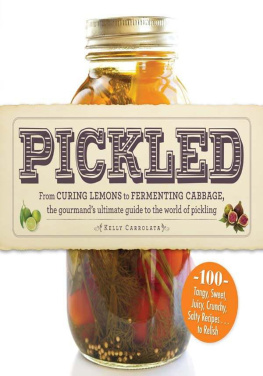
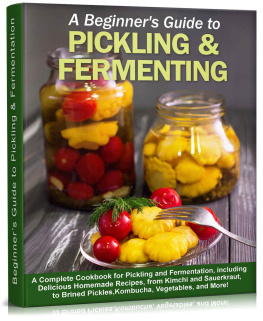
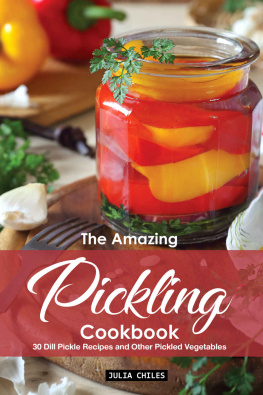
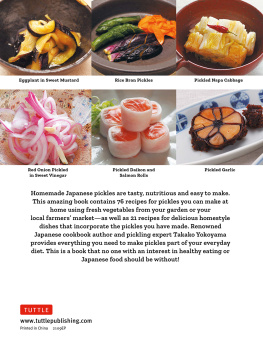

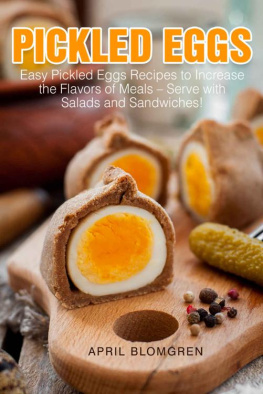
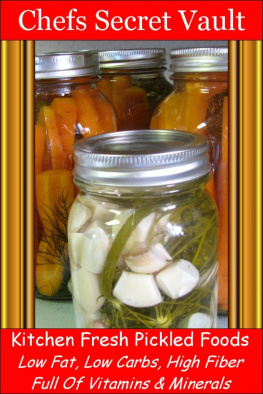
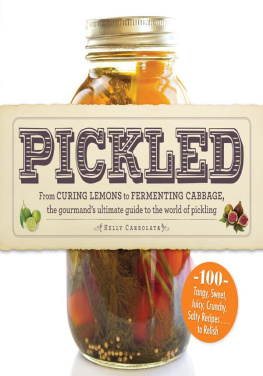

 K ELLY C ARROLATA
K ELLY C ARROLATA 





